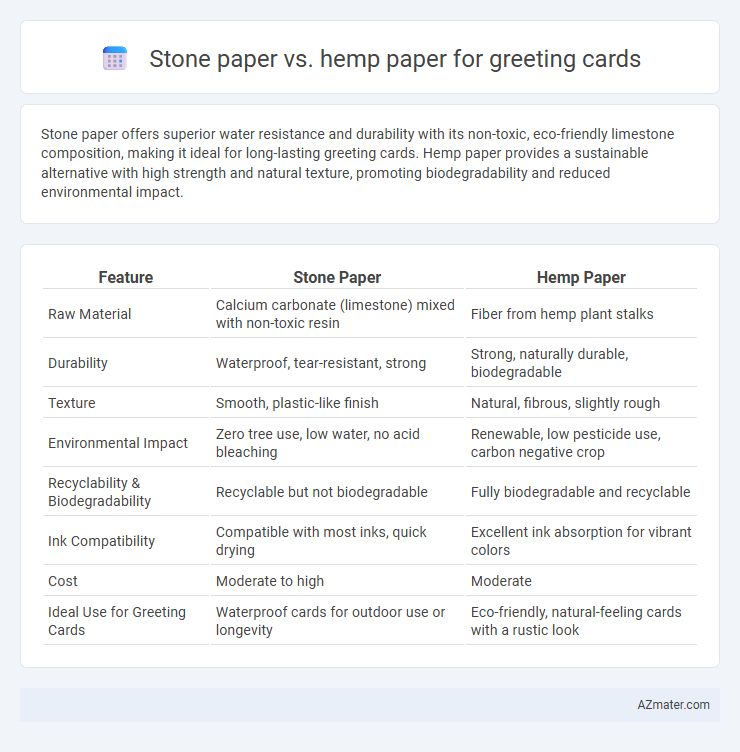Stone paper offers superior water resistance and durability with its non-toxic, eco-friendly limestone composition, making it ideal for long-lasting greeting cards. Hemp paper provides a sustainable alternative with high strength and natural texture, promoting biodegradability and reduced environmental impact.
Table of Comparison
| Feature | Stone Paper | Hemp Paper |
|---|---|---|
| Raw Material | Calcium carbonate (limestone) mixed with non-toxic resin | Fiber from hemp plant stalks |
| Durability | Waterproof, tear-resistant, strong | Strong, naturally durable, biodegradable |
| Texture | Smooth, plastic-like finish | Natural, fibrous, slightly rough |
| Environmental Impact | Zero tree use, low water, no acid bleaching | Renewable, low pesticide use, carbon negative crop |
| Recyclability & Biodegradability | Recyclable but not biodegradable | Fully biodegradable and recyclable |
| Ink Compatibility | Compatible with most inks, quick drying | Excellent ink absorption for vibrant colors |
| Cost | Moderate to high | Moderate |
| Ideal Use for Greeting Cards | Waterproof cards for outdoor use or longevity | Eco-friendly, natural-feeling cards with a rustic look |
Introduction to Alternative Papers for Greeting Cards
Stone paper and hemp paper offer sustainable alternatives to traditional wood-pulp greeting cards, each providing unique environmental benefits and tactile qualities. Stone paper is made from calcium carbonate bonded with non-toxic resin, making it waterproof, tear-resistant, and smooth, while hemp paper, derived from fast-growing hemp fibers, is biodegradable, durable, and has a natural texture favored for eco-conscious designs. Both materials reduce deforestation and water consumption compared to conventional paper, positioning them as innovative choices for environmentally friendly greeting cards.
What is Stone Paper?
Stone paper is an innovative material made from calcium carbonate bonded with non-toxic resin, offering durability and water resistance without the use of wood pulp or water in production. Unlike hemp paper, which relies on fibrous plant material, stone paper provides a smooth, tear-resistant surface ideal for high-quality greeting cards. Its eco-friendly manufacturing process reduces deforestation and pollution, making it a sustainable alternative in the printing and stationery industry.
What is Hemp Paper?
Hemp paper, made from the fibers of the hemp plant, offers a sustainable alternative to traditional wood-pulp paper, renowned for its durability, softness, and eco-friendly qualities. It contains higher cellulose content which enhances strength and longevity, making it ideal for premium greeting cards that withstand wear and tear. Compared to stone paper, hemp paper is biodegradable and supports renewable agriculture, appealing to environmentally conscious consumers.
Environmental Impact: Stone Paper vs Hemp Paper
Stone paper is crafted from calcium carbonate and resin, offering a tree-free alternative that reduces deforestation but requires energy-intensive manufacturing processes with potential plastic pollution from resin. Hemp paper, derived from fast-growing hemp plants, promotes carbon sequestration, requires less water and pesticides than traditional wood pulp, and is biodegradable, making it a more sustainable option for eco-friendly greeting cards. Choosing hemp paper over stone paper significantly lowers the environmental footprint by minimizing plastic waste and enhancing biodegradability in waste disposal.
Durability and Strength Comparison
Stone paper offers superior tear resistance and water durability compared to hemp paper, making it ideal for greeting cards that need to withstand handling and moisture. Hemp paper, while strong and eco-friendly, tends to be more fibrous and can degrade faster under wet conditions. Choosing stone paper ensures longer-lasting greeting cards with enhanced resilience and minimal wear over time.
Print Quality and Texture for Greeting Cards
Stone paper offers a smooth, waterproof texture with excellent print clarity, making colors appear vibrant and sharp on greeting cards. Hemp paper provides a natural, fibrous texture that enhances a rustic, organic look but may result in slightly muted print quality compared to stone paper. For premium greeting cards, stone paper ensures crisp graphic details, while hemp paper appeals to eco-conscious customers valuing tactile authenticity.
Cost and Availability of Stone and Hemp Paper
Stone paper is generally more expensive than hemp paper due to its unique manufacturing process using calcium carbonate, but it offers water resistance and durability ideal for premium greeting cards. Hemp paper is relatively affordable and gaining availability as hemp cultivation expands, benefiting from eco-friendly appeal and faster growth cycles. While stone paper's production is limited to specialized facilities, hemp paper is increasingly accessible through sustainable forestry supply chains and agricultural regulations easing worldwide.
Creative Design Possibilities
Stone paper offers a smooth, tear-resistant surface ideal for vibrant, high-resolution printing that enhances intricate greeting card designs with vivid colors and sharp details. Hemp paper provides a natural texture with durability and eco-friendliness, complementing rustic, handmade aesthetic designs that appeal to environmentally conscious consumers. Both materials support unique creative expressions, with stone paper emphasizing modern, sleek visuals and hemp paper favoring organic, tactile experiences.
Consumer Preferences and Market Trends
Stone paper offers durability and water resistance, appealing to eco-conscious consumers seeking sustainable alternatives to traditional paper. Hemp paper, valued for its natural texture and recyclability, attracts buyers interested in organic and biodegradable options for greeting cards. Current market trends indicate growing demand for environmentally friendly materials, with hemp paper gaining traction for its renewable cultivation benefits and stone paper favored for its innovative, plastic-free composition.
Which Paper Should You Choose for Greeting Cards?
Stone paper offers exceptional durability and water resistance, making greeting cards more resistant to tearing and environmental damage, while hemp paper provides a sustainable, eco-friendly option with a natural texture and excellent print quality. For lasting, resilient greeting cards that withstand handling and moisture, stone paper is ideal; for those prioritizing environmental impact and a traditional tactile feel, hemp paper is the preferred choice. Your decision should consider factors such as budget, desired card longevity, and commitment to sustainability.

Infographic: Stone paper vs Hemp paper for Greeting card
 azmater.com
azmater.com